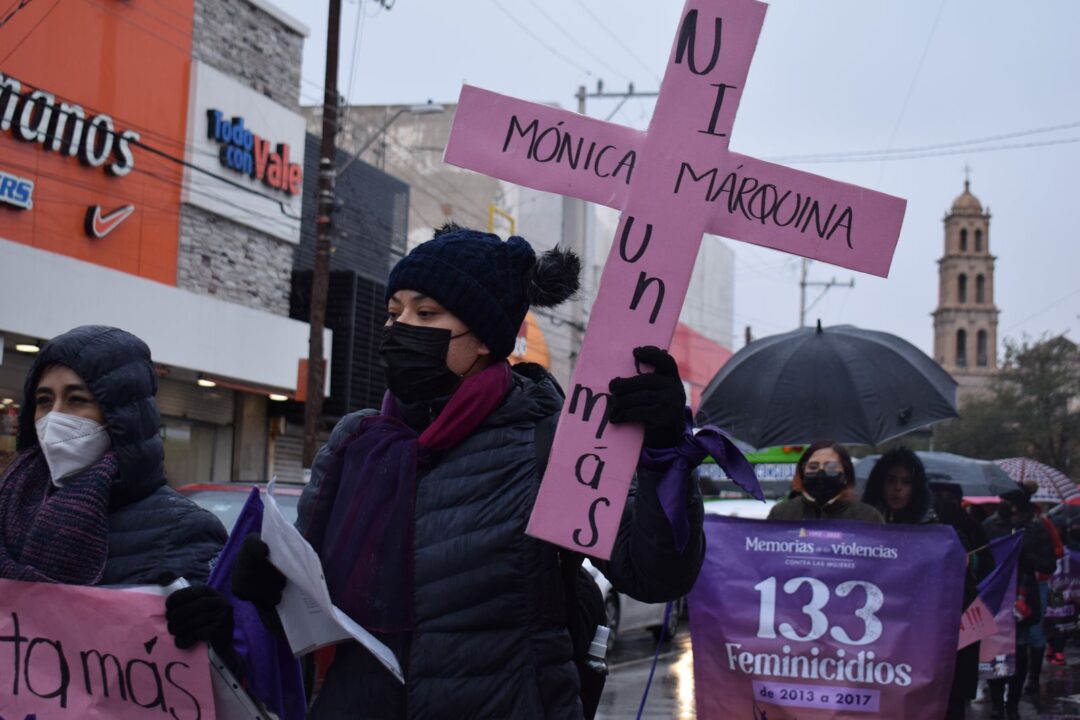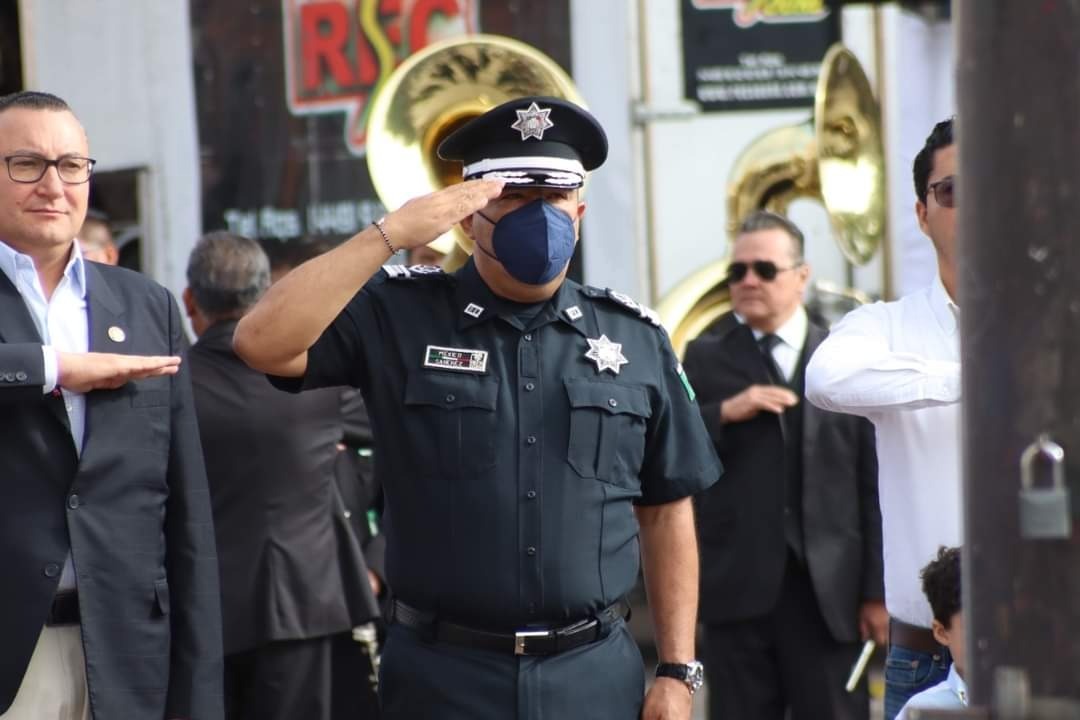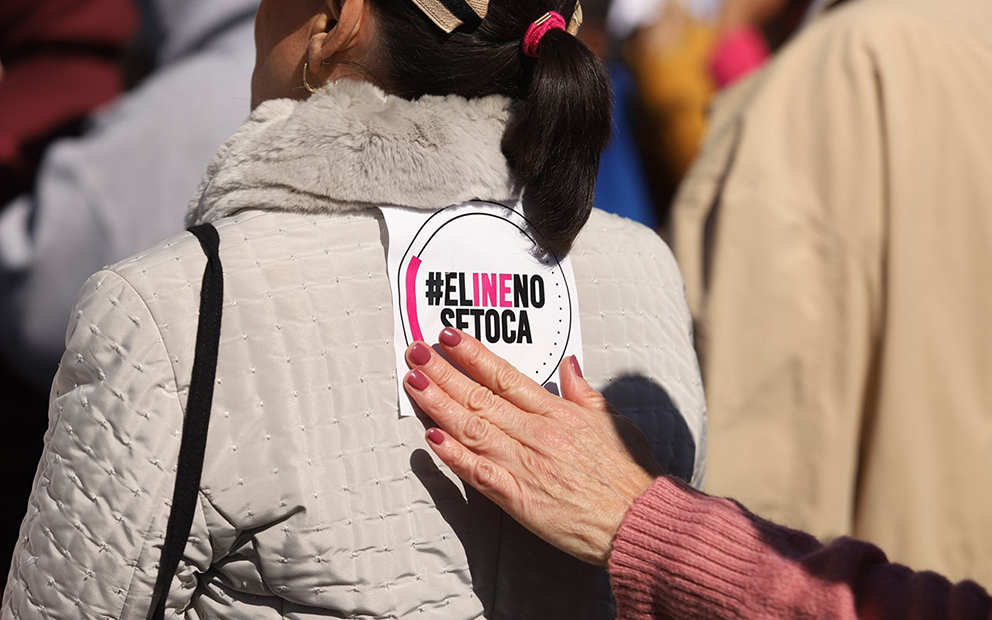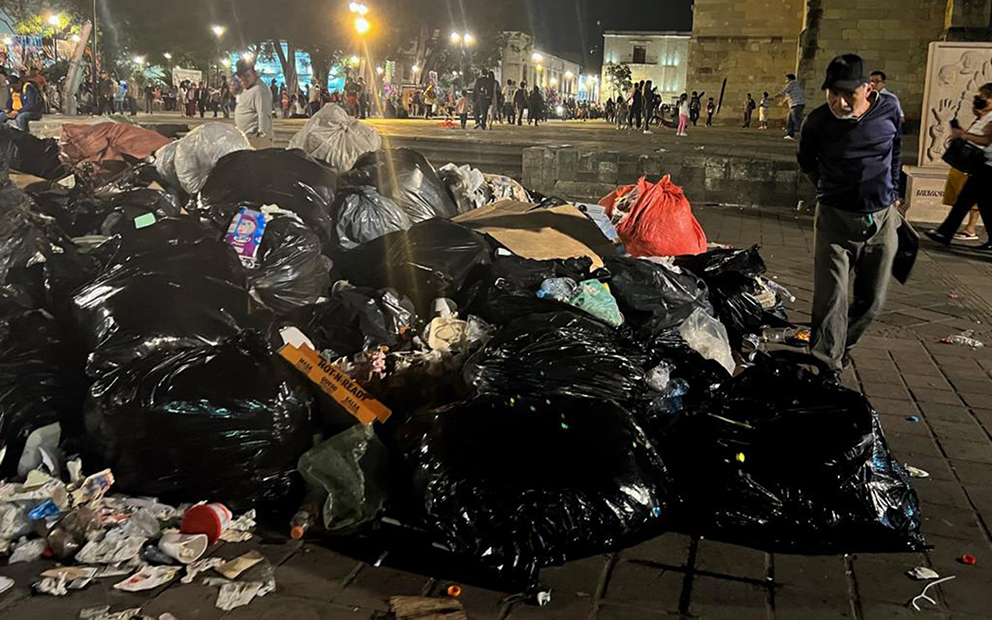What’s behind months of water shortages in Monterrey?
5 agosto, 2022
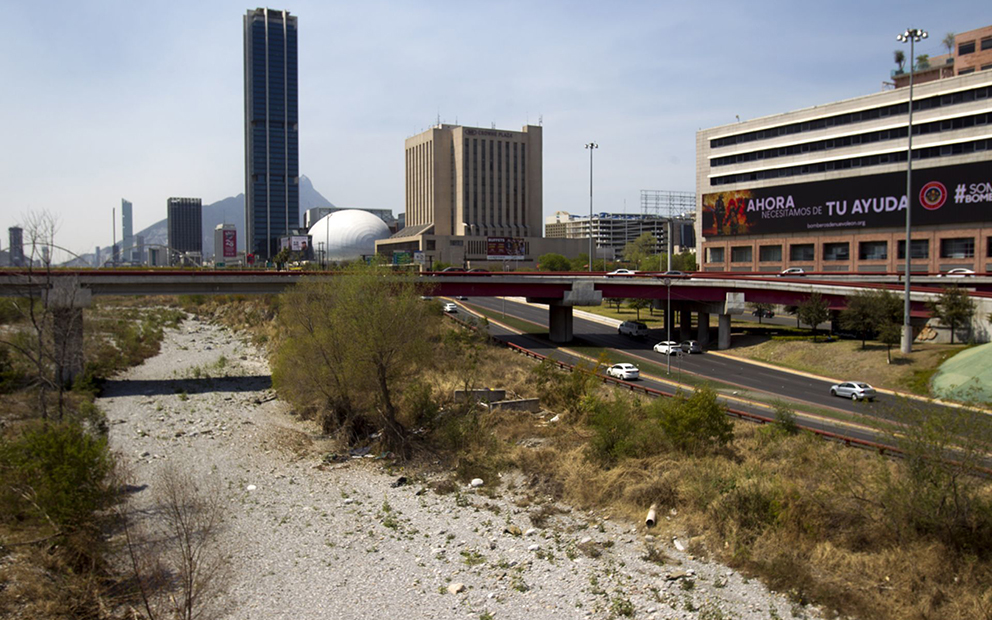
A drought ten years ago should have put the authorities on maximum alert. Instead, they improvised in response. Today there are an estimated 5.5 million people in Monterrey without regular access to water.
Text by Ignacio Alvarado Álvarez, originally published July 28, 2022.
Photos by Gabriela Pérez Montiel / Cuartoscuro.
Translation by Dawn Marie Paley for Pie de Página in English.
NUEVO LEÓN—At the beginning of 2011, the year he arrived to live briefly in Monterrey, David Ortega-Gaucin was preparing to carry out an investigation that would, two years later, offer an end times diagnosis for agricultural production in the region. Nuevo León and the rest of the Mexican north were entering into one of the worst droughts on record, and it wasn’t prepared to deal with a climate emergency of that magnitude.
What the researcher from the Mexican Institute of Water Technology (IMTA) found during the months that he carried out documentation and fieldwork provided enough evidence that he could see, as if he was looking into a crystal ball, the catastrophic future that is unfolding today. Although his research was focussed on agricultural processes, he warned of lacking infrastructure and technology, under the administration of a government with little awareness of what was to come.
“We should consider that the drought is a persistent and recurring phenomenon, which, by using a holistic planning process, can be managed without improvisation, which only allows a partial response to the emergency without resolving the issue at its heart,” said Ortega-Gaucin at the end of 2012, when he presented the results of his study to the Water Institute of the state of Nuevo León.
Ten years later, Ortega is witness to the troubles unleashed by drought and the lack of water. “It’s clear that there was a lack of vision on the part of the previous government regarding the implementation of preventative measures and mitigation,” he said. “That’s unfortunate, because in Nuevo León, and also in other parts of the country, there have been recurring crises which are becoming more catastrophic not just because of drought but because of how the governments are managing water use.”
The 2011 drought, which is a point of reference for many specialists that today study the impacts of the lack of the resource on the Metropolitan Area of Monterrey (AMM), was more severe than that which is currently underway. But it didn’t get the same attention as what is taking place today, because it came one year after hurricane Alex. Heavy rainwater led to flooding of the Santa Catarina River, blocking key arteries in the city and filling three reservoirs that supply drinking water to the brim. There was always enough water.
But on the margins of the urban area, the lack of rain had a different effect. The disorder in policies regulating ranching and agriculture, as well as the shoddy administration of natural resources, were having impacts that should have alerted authorities. Deforestation and overgrazing degraded around six million hectares, which is the equivalent of 92 percent of the state’s land. The reduction of forest resources, erosion and the reduction in the land’s fertility meant that there were nearly irreversible levels of desertification, according to Ortega’s research.
With this context in mind, the institutional response with projects to manage and later revert the impacts of drought, which is a phenomenon that has been occurring periodically over centuries, should be obvious. But there was none.
Since 2010, there hasn’t been another rain event that has been enough to boost water levels in reservoirs to a healthy level. Nor were the agricultural systems brought up to date with improved technology, and most of them still operate according to traditional methods. In addition, there have been no investments in water treatment plants or the drilling of wells in a systematic fashion.
Nuevo León is today a mirror in which neighboring states, at the very least, can see themselves reflected. The 2011 drought had negative impacts around the country, and led to the adoption of the federal government’s National Program Against Drought in 2013. Representatives from México’s 26 watersheds wrote a document called Program of Preventative Measures and Drought Mitigation, which included specific designs for each region.
None of what was written in those programs was implemented in any of the watershed areas. In the best of cases, there were drafts drawn up. The idea of preparing for a coming drought was to prevent situations like that which Nuevo León is currently going through, with zero water in the reservoirs and social mobilization at a level it has not been seen in similar crises in the recent past.
The lack of water began to become apparent in the spring. That’s when the federal government began to talk about plans to be carried out in the medium term, even while holding on to hope that a more immediate supply of water would become available during the hurricane season, which didn’t happen. The dearth continued as the weeks went on, reaching a critical phase in May, when temperatures started to rise. It was just the beginning of the catastrophe.
As the weeks went by, the state government was forced to reduce the number of days in which water was available in the metropolitan area, which means we were going three days without water. One needs to be aware of when water is available, because pressure is very low and it takes between 10 and 15 minutes to fill a 10 liter bucket. And the heat is intense, above 40 degrees Celsius. The conditions are terrible,” said a man who goes by the name Hispanoparlante, and who lives in the Villas de Santa Rosa neighborhood in Apodaca, in Greater Monterrey.
At the entry to his neighborhood the municipal government began to provide water in containers. To access them, residents would line up beginning at dawn. The water they provided was not drinkable, but rather for use in bathrooms and for cleaning. There’s also places where purified water was previously available, for the normal price. But today, those sources are also dried up.
“The citizens are worried, and they’ve gone out into the streets to protest, to demonstrate; they’ve been forced to block roads so that the authorities and the media pay attention to the issue of the lack of water,” said Hispanoparlante.
“But there are also sectors, and I know this because of friends and family members, which have never gone without water, like the University Hospital area, or San Nicolás, or a residential area called Los Puentes. Their water pressure is the same [as it was before the drought], and I haven’t seen news reports about why that is,” he said.
The poorer and more populous areas of the AMM are, effectively, those with the most issues related to a lack of water. The way the alternative cuts to the supply of water has been implemented has not been transparent, as much as authorities claim otherwise. They were, however, very specific about the search for new water sources, which meant that farmers from nearby municipalities in turn blocked federal highways for days.
Antonio Hernández, who is a biologist and a local activist, predicts more citizen revolts as the crisis advances, because he doesn’t think it will end until winter arrives. No other crisis—including the violence—has generated a response like that seen in the past few weeks. “I’m 48 years old and I’ve never seen anything like this,” he said in an interview with journalist Julio Hernández. “This is the issue that has been a catalyst for social discontent connected to many other things.”
Hernández, who is an expert in the management of natural protected áreas and a member of the collective Pueblo Bicicletero, mapped the residences of San Pedro Garza García, the richest municipality per capita in Latin America, and offered an inventory of inequality in access to water during critical moments. He counted 600 residences with swimming pools, many of them near Governor Samuel García’s home.
That would matter little, if it wasn’t for the fact that García has been asking the population not to use water indecently, while his neighbors organize parties and get togethers at their private pools.
Money matters in critical moments. Just like in the neighborhoods mentioned by Hispanoparlante, the residential áreas in San Pedro Garza García have seen very few consequences of the drought. The municipality is home to the richest men not just in the state, but in the entire country. Some of them are owners of businesses in the industries accused of hoarding underground water sources via concessions granted by the National Water Commission (CONAGUA).
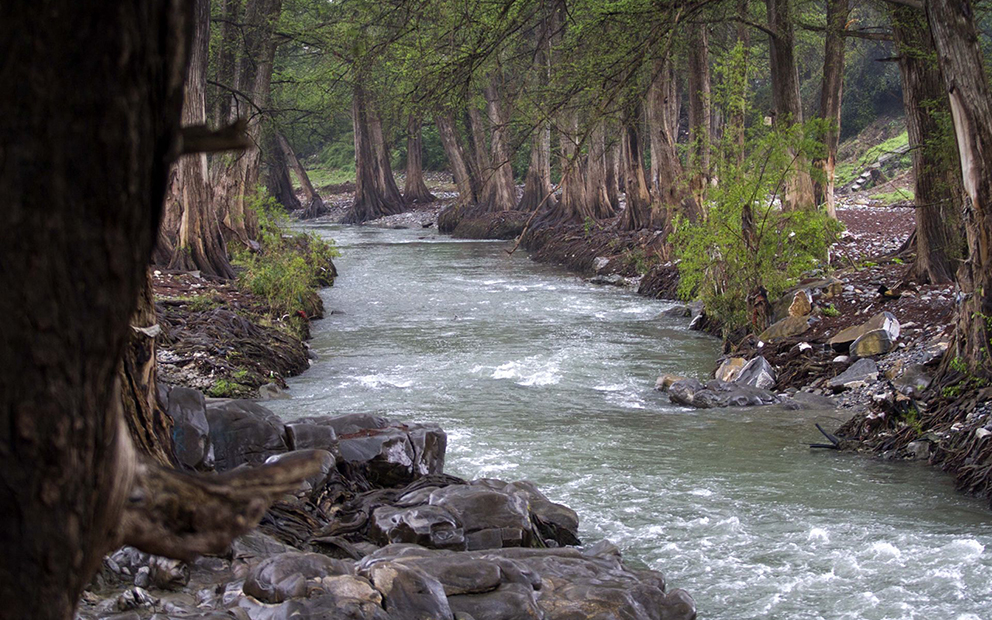
Industry and the agricultural sector, which as the IMTA researcher said, operate without updated technology and lose up to 60 per cent of the water being sent through the system, are the largest consumers of the resource, and they haven’t stopped being so in the midst of the current emergency. Both sectors have claimed that the water they have concessions for represents only four percent of the total, three percent less than that recorded by CONAGUA. But, according to the biologist and activist, that is a percentage of the total water available in the state, not in the AMM.
“Industrial activity is concentrated to a significant extent in the metropolitan area. So if we do an evaluation of the water that is concessioned for industrial use, we’re talking about 37 percent. If we add to that other processes that have to do with industry and agriculture, we’d be talking about 59 percent of private water use in the metropolitan area.”
Antonio Hernández, biologist and activist.
Hernández makes a point of noting the amount of water used by a single steel company, Ternium. Its concession to use underground water is 13 cubic meters per second, which is equivalent to the 16,000 liters per second needed by the residents of the AMM, he says. After Ternium, which has its head offices in Luxemburg, are the Heineken brewery and the Coca-Cola-Femsa conglomerate.
In 2020, Salvador Corrales, a researcher with El Colegio de la Frontera Norte (COLEF), published the results of an investigation on the use of water by the beer giant in the context of a water crisis. Heineken, which owns the Cuauhtémoc-Moctezuma brand, has 11 water concessions with CONAGUA. Taken together, the company is allowed to use 6.3 million cubic meters per second.
Beer production has been climbing over the last two decades, and México has long been the main exporter on earth, producing nearly a quarter of the world’s total beer exports. The growth of that market has put pressure on production levels, which in turn impact water consumption. The majority of México’s biggest breweries are in the country’s north, where there is less water. In the case of Heineken, Corrales’ investigation found the company only used 39.9 percent of the water concessioned to it prior to the current crisis.
According to my calculations, the number of liters of water needed to produce a liter of beer is actually quite low. They are very advanced technologically and have significant water savings for their production level with respect to the international average, which is to say, they don’t use all the water that is concessioned to them.”
Salvador Corrales, COLEF
Thus, the company could easily concede some of its water to relieve some of the shortages in Monterrey, he said. He disagrees with Hernández, and believes that diverting the water used by the soft drink and steel industry wouldn’t be enough to alleviate the crisis.
At the beginning of July, President López Obrador suggested to Governor García that he negotiate with industry to control the effects of the crisis. “It’s a matter of imagination,” said the president. There was, two years ago, a moment when it became possible to measure industrial water use and the lack of water, to see if putting the brakes on industry could potentially be a saving grace if water shortages became more severe.
In May of 2020, the beer industry stopped production during the national emergency that was declared because of the pandemic.
“We couldn’t trace anything because they have independent wells,” said the COLEF researcher. “The municipal supply of water, in the case of the city of Monterrey, comes from, or used to come from, three reservoirs and around 500 wells connected to the water system. And as we don’t know how much there is underground, we can’t measure it. In addition, during that time there was water, though there was a deficit due to the unorganized growth of the city. But there’s no data that shows the volumes of savings that could have occurred.”
Corrales doesn’t see the shuttering of industry as a means of dealing with the crisis. Neither does David Ortega-Gaucin of the IMTA.
“In the case of the soft drink industry it could be viable to have them stop producing a percentage. Obviously there would have to be negotiations with the owners, because the losses would be in the multi-millions. But in the case of the steel industry, I think it would be really complicated because Nuevo León, and Monterrery, have a long history with it, and its development is deeply linked to the sector. Same goes for the beer industry,” he said.
Ternium, which heads Latin American production of steel sheets and beams used by the car making and energy sectors, would be the least willing to sign on to such a plan, at least according to their plans to continue to grow their operations in the state. In February of this year, the company announced a one billion peso (US$50 million) investment for that purpose.
Halfway through the crisis the government of Nuevo León presented its Master Plan to Guarantee Water until 2050. The first phase discusses rehabilitating and drilling around 100 wells, repairing leaks in water pipes, declaring an emergency, using water trucks to deliver water, and raising the cost of water service so as to “incentivize conserving water and the value of the water,” as well as the donation of water from some irrigation districts. In the medium and long term, the Plan discusses public works which would allow for another 30 million cubic liters of water to be made available to the system, which is almost twice what is currently required. That is, if everything goes according to plans.
In order to encourage citizens who are becoming more and more desperate, García’s administration launched a 30 second video clip. “In the new Nuevo León, we’re working to make sure everyone has water. We are seeding the clouds, you, take a three minute shower,” says the first line of the commercial. But in popular neighborhoods, there’s no water coming out of showers to begin with, and cloud seeding has been a failure till today.
In any case, the proposals in the Master Plan are among the suggestions that were part of the 2013 agreement, after the drought that took place then. Which is to say, they were never implemented. Because of that, the provisions of the government are closer to a political reaction than to a true act of strategic planning. There’s nothing new, nothing that has been done in the present to address the crisis.
“Public policy with relation to water, even though there are plans drawn up every six years, normally isn’t part of urban development,” said researcher Ortega-Gaucin. “So there will never be enough water. There is a limit to how much is available. Monterrey is a city located in a semi-desert, which lacks water. But we cannot confuse a lack of water with a drought. A lack of water is when there is more demand than supply. Monterrey, because of its unplanned growth, has a lack of water that has been aggravated through the bad management of public policies.”
Click here to sign up for Pie de Página’s bi-weekly English newsletter.
Ayúdanos a sostener un periodismo ético y responsable, que sirva para construir mejores sociedades. Patrocina una historia y forma parte de nuestra comunidad.
Dona

